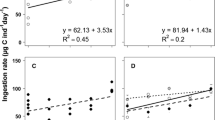Abstract
A recent hypothesis in the zooplankton literature states that zooplankton acclimate to ambient food concentrations such that higher digestive enzyme activities and, consequently, higher maximum ingestion rates are achieved at higher food levels. To test this hypothesis, adult female Calanus pacificus, collected from the main basin of Puget Sound, Washington, USA, in August 1979 and May 1982, were conditioned for 2 wk at different concentrations of the diatom Thalassiosira weissflogii (=fluviatilis). Ingestion rates and the activity of the digestive enzymes laminarinase, maltase, and cellobiase were measured periodically during acclimation and in a block-designed feeding experiment at the end of acclimation. Consistent with the hypothesis, maximum ingestion rate and digestive enzyme activity were positively correlated. However, in contrast to the hypothesized mechanism, this result arose because both maximum ingestion rate and digestive enzyme activity were negatively correlated with food concentration during acclimation. The enhanced ingestion of copepods following long-term (12 to 14 d) acclimation to low food is similar to that previously described for short-term (e.g. 1 d) starvation. It might be energetically optimal for copepods experiencing a patchy food environment to maintain higher levels of digestive enzymes at low food concentrations in order to exploit high concentrations of food when encountered.
Similar content being viewed by others
Literature cited
Arnaud, J., M. Brunet and J. Mazza: Studies on the midgut of Centropages typicus (copepod, calanoid). I. Structural and ultrastructural data. Cell Tissue Res. 187, 333–353 (1978)
Conover, R. J.: Feeding interactions in the pelagic zone. Rapp. P.-v Réun. Cons. perm. int. Explor. Mer 173, 66–76 (1978)
Conover, R. J. and P. Mayzaud: Respiration and nitrogen excretion of neritic zooplankton in relation to potential food supply. Proc. 10th Eur. mar. Biol. Symp. 2, 151–163 (1976). (Ed. by G. Persoone and E. Jaspers. Wetteren, Belgium: Universa Press)
Cox, J. L.: Laminarinase induction in marine zooplankton and its variability in zooplankton samples. J. Plankton Res. 3, 345–356 (1981)
Cox, J. L. and S. W. Willason: Laminarinase induction in Calanus pacificus. Mar. Biol. Lett. 2, 307–311 (1981)
Dadd, R. H.: Proteolytic activity of the midgut in relation to feeding in the beetles Tenebrio molitor L. and Dytiscus marginalis L. J. exp. Biol. 33, 311–324 (1956)
Enright, J. T.: Diurnal vertical migration: adaptive significance and timing. Part I. Selective advantage: a metabolic model. Limnol. Oceanogr. 22, 856–872 (1977)
Frost, B. W.: Effects of size and concentration of food particles on the feeding behavior of the marine planktonic copepod Calanus pacificus. Limnol. Oceanogr. 17, 805–815 (1972)
Frost, B. W.: Feeding processes at lower trophic levels in pelagic communities. In: The biology of the oceanic Pacific, pp 59–77. Ed. by C. B. Miller. Oregon: State University Press (1974)
Frost, B. W.: A threshold feeding behavior in Calanus pacificus. Limnol. Oceanogr. 20, 263–266 (1975)
Frost, B. W.: Feeding behavior of Calanus pacificus in mixtures of food particles. Limnol. Oceanogr 22, 472–491 (1977)
Hallberg, E. and H.-J. Hirche: Differentiation of mid-gut in adults and overwintering copepodids of Calanus finmarchicus (Gunneras) and C. helgolandicus Claus. J. exp. mar. Biol. Ecol. 48, 283–295 (1980)
Handa, N. and H. Tominaga: A detailed analysis of carbohydrates in marine particulate matter. Mar. Biol. 2, 228–235 (1969)
Hassett, R. P. and M. R. Landry: Digestive carbohydrase activities in individual marine copepods. Mar. Biol. Lett. 3, 211–221 (1982)
Huntley, M.: Nonselective, nonsaturated feeding by three calanid copepod species in the Labrador Sea. Limnol. Oceanogr. 26, 831–842 (1981)
Lam, R. K. and B. W. Frost: Model of copepod filtering response to changes in size and concentration of food. Limnol. Oceanogr. 21, 490–500 (1976)
Lowry, O. H. and J. V. Passonneau: A flexible system of enzymatic analysis, 291 pp. New York: Academic Press 1972
Mayzaud, P.: Some sources of variability in determination of digestive enzyme activity in zooplankton. Can. J. Fish. aquat. Sciences 37, 1426–1432 (1980)
Mayzaud, P. and R. J. Conover: Influence of potential food supply on the activity of digestive enzymes of neritic zooplankton. Proc. 10th Eur. mar. Biol. Symp. 2, 415–427 (1976). (Ed. by G. Persoone and E. Jaspers Wetteren, Belgium: Universa Press)
Mayzaud, P. and S. A. Poulet: The importance of the time factor in the response of zooplankton to varying concentrations of naturally occurring particulate matter. Limnol. Oceanogr. 23, 1144–1154 (1978)
McAllister, C. D.: Zooplankton rations, phytoplankton mortality, and the estimation of marine production. In: Marine food chains, pp 419–457. Ed. by J. H. Steele. Berkeley: University of California Press 1970
McLaren, I.A.: Generation lengths of some temperate marine copepods: estimation, prediction and implications. J. Fish. Res. Bd Can. 35, 1330–1342 (1978)
Mullin, M. M.: Some factors affecting the feeding of marine copepods of the genus Calanus. Limnol. Oceanogr. 8, 239–250 (1963)
Poulet, S. A.: Seasonal grazing of Pseudocalanus minutus on particles. Mar. Biol. 25, 109–123 (1974)
Runge, J. A.: Effects of hunger and season on the feeding behavior of Calanus pacificus. Limnol. Oceanogr. 25, 134–145 (1980)
Vidal, J.: Physioecology of zooplankton. I. Effects of phytoplankton concentration, temperature, and body size on the growth rate of Calanus pacificus and Pseudocalanus sp. Mar. Biol. 56, 111–134 (1980)
Vlymen, W. J.: Energy expenditure of swimming copepods. Limnol. Oceanogr. 15, 348–356 (1970)
Author information
Authors and Affiliations
Additional information
Communicated by N. D. Holland, La Jolla
Contribution No. 1311 from the School of Oceanography, University of Washington, Seattle, Washington 98195, USA
Rights and permissions
About this article
Cite this article
Hassett, R.P., Landry, M.R. Effects of food-level acclimation on digestive enzyme activities and feeding behavior of Calanus pacificus . Mar. Biol. 75, 47–55 (1983). https://doi.org/10.1007/BF00392629
Accepted:
Issue Date:
DOI: https://doi.org/10.1007/BF00392629




